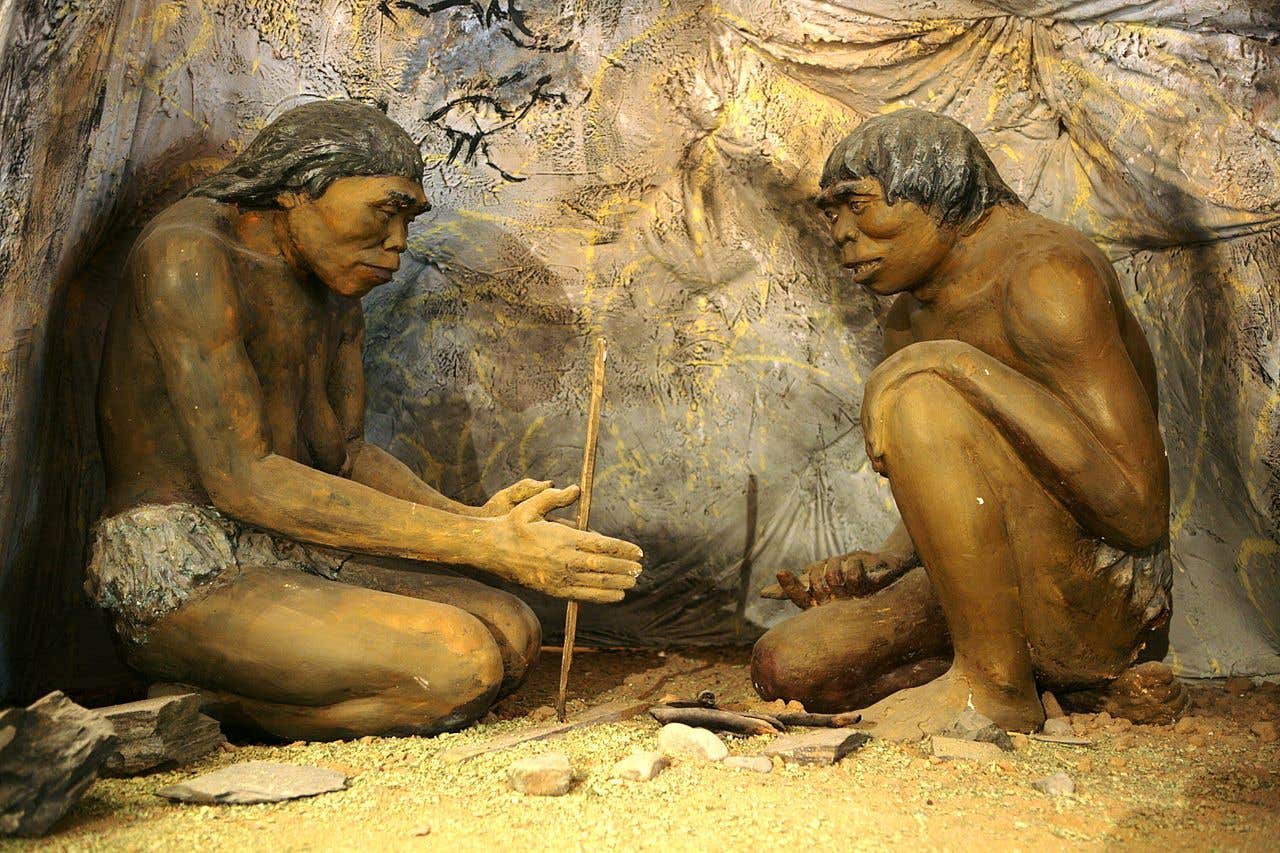A single protein may have sparked the origin of human language
A human-specific NOVA1 gene mutation may have shaped the evolution of speech, distinguishing modern humans from Neanderthals and Denisovans.

Scientists have identified a genetic mutation in the NOVA1 gene that may have enabled early humans to develop spoken language. (CREDIT: CC BY-SA 4.0)
For thousands of years, spoken language has set humans apart from all other species. The ability to convey complex ideas, describe experiences, and communicate across generations has played a crucial role in shaping civilization. But what enabled early humans to develop this extraordinary skill while our closest relatives, such as Neanderthals and Denisovans, did not?
Scientists have long sought answers by examining fossilized skulls, anatomical structures, and genetic clues. While Neanderthals may have had the physical ability to speak, modern humans are the only known species to develop advanced linguistic skills. Now, researchers have uncovered a genetic mutation that could have played a pivotal role in the emergence of human speech.
A study from The Rockefeller University has identified a human-specific variant of the NOVA1 gene, a key player in brain development. This variation, absent in Neanderthals and Denisovans, may have contributed to the evolution of spoken language.
The findings, published in Nature Communications, suggest that a single amino acid change in NOVA1 altered the way early humans processed vocalization-related neural signals, setting them on a unique evolutionary trajectory.
The Role of NOVA1 in Neural Development
The NOVA1 gene encodes an RNA-binding protein that regulates neural development and motor control. First discovered in 1993, it plays a vital role in brain function. In mice, deleting the gene results in severe motor dysfunction and early death. In humans, rare mutations in NOVA1 have been linked to language delays, learning disabilities, and behavioral disorders.
Unlike other species, modern humans carry a distinct version of NOVA1, characterized by a single amino acid substitution at position 197, where isoleucine is replaced with valine (I197V). This change is found in virtually all modern humans but is absent in our closest extinct relatives.
To understand its impact, researchers used CRISPR gene-editing technology to replace the standard NOVA1 protein in mice with the human-specific variant. They then analyzed the mice’s vocalizations, a crucial aspect of communication in many species. The results were striking: the genetically modified mice produced altered vocal patterns compared to their wild-type counterparts.
Related Stories
“These changes in vocalization patterns suggest that NOVA1 may have played a role in the evolution of human speech,” explains Robert B. Darnell, the study’s senior author. “It’s part of a broader set of genetic changes that may have collectively enabled our ancestors to develop spoken language.”
Genetic Clues from Archaic Humans
To confirm that this variant was unique to modern humans, researchers compared the NOVA1 sequences from three Neanderthal genomes and one Denisovan genome. None of these archaic humans carried the I197V mutation. Instead, they had the ancestral form found in all non-human animals.
Next, scientists examined a massive database containing over 650,000 modern human genomes. Nearly every individual carried the human-specific variant, with only six exceptions. These six people had the archaic form, suggesting that while the mutation became widespread in human populations, some rare individuals retained the older version.
The researchers propose that the I197V substitution arose in an ancestral human population in Africa before Homo sapiens spread across the globe. This genetic shift may have provided an advantage related to vocal communication, helping early humans coordinate complex activities and pass down knowledge.
Implications for Language and Neurological Disorders
The discovery of NOVA1’s role in vocalization has broad implications, not just for understanding human evolution but also for studying speech-related disorders. Many neurological conditions, including autism spectrum disorder, are linked to mutations in genes that regulate neural development. Since NOVA1 is involved in RNA processing, disruptions to this gene may contribute to conditions that affect language and cognition.
In 2023, researchers identified a patient with a NOVA1 mutation who exhibited delayed speech, learning disabilities, and motor hyperactivity. Understanding how this gene influences vocalization could lead to new insights into conditions such as nonverbal autism, speech apraxia, and neurodegenerative diseases that affect communication abilities.
“This finding opens the door for future studies on how NOVA1 functions in humans,” says Yoko Tajima, the study’s lead author. “By exploring how it regulates neural circuits, we may gain a better understanding of both typical language development and speech disorders.”
While NOVA1 is just one piece of the puzzle, its role in shaping vocal communication provides a fascinating glimpse into the genetic changes that made human speech possible.
As researchers continue to unravel the mysteries of language evolution, they may uncover even more genetic clues that explain why Homo sapiens became the world’s only truly talking species.
Earliest Spoken Languages on Earth
The earliest known spoken languages on Earth date back tens of thousands of years, but because spoken language leaves no direct evidence, much of what we know is inferred from historical linguistics, archaeology, and anthropology. Here are some of the earliest known languages:
Proto-Languages (Pre-Writing Era, ~50,000–3,000 BCE)
These are hypothetical ancestor languages reconstructed by linguists:
- Proto-Indo-European (PIE) – The ancestor of Sanskrit, Latin, Greek, and many modern languages in Europe and South Asia.
- Proto-Afroasiatic – Likely the ancestor of Ancient Egyptian, Semitic languages (Akkadian, Hebrew, Arabic), and Berber.
- Proto-Sino-Tibetan – The root of Chinese, Burmese, and Tibetan languages.
- Proto-Dravidian – The precursor to Tamil, Telugu, and other Dravidian languages in South India.
- Proto-Austronesian – An early language of Southeast Asia and the Pacific, leading to languages like Malay, Tagalog, and Hawaiian.
Earliest Recorded Languages (~3,100 BCE Onward)
These languages were among the first to be written down:
- Sumerian (c. 3100 BCE) – The world's first known written language, used in Mesopotamia (modern Iraq). It was a language isolate (not related to any known language).
- Egyptian (c. 3100 BCE) – The language of ancient Egypt, with hieroglyphic inscriptions that persisted for thousands of years.
- Akkadian (c. 2500 BCE) – A Semitic language spoken in Mesopotamia, replacing Sumerian as a dominant language.
- Elamite (c. 2700 BCE) – A language spoken in what is now Iran, with its own unique script.
- Hittite (c. 1600 BCE) – An Indo-European language written in cuneiform in Anatolia (modern Turkey).
Other Ancient Languages with Early Texts
- Sanskrit (c. 1500 BCE) – One of the oldest Indo-European languages, first seen in the Rigveda.
- Chinese (Oracle Bone Script, c. 1200 BCE) – The oldest written form of the Chinese language.
- Mycenaean Greek (Linear B, c. 1400 BCE) – The earliest form of Greek, written in the Linear B script.
The Origins of Spoken Language
The first spoken languages likely developed at least 50,000–100,000 years ago, with some theories suggesting early forms as far back as 2 million years ago in early Homo species. These prehistoric languages would have evolved from simple vocalizations into complex grammar systems, eventually forming the ancestors of today’s languages.
Note: Materials provided above by The Brighter Side of News. Content may be edited for style and length.
Like these kind of feel good stories? Get The Brighter Side of News' newsletter.
Joseph Shavit
Head Science News Writer | Communicating Innovation & Discovery
Based in Los Angeles, Joseph Shavit is an accomplished science journalist, head science news writer and co-founder at The Brighter Side of News, where he translates cutting-edge discoveries into compelling stories for a broad audience. With a strong background spanning science, business, product management, media leadership, and entrepreneurship, Joseph brings a unique perspective to science communication. His expertise allows him to uncover the intersection of technological advancements and market potential, shedding light on how groundbreaking research evolves into transformative products and industries.



